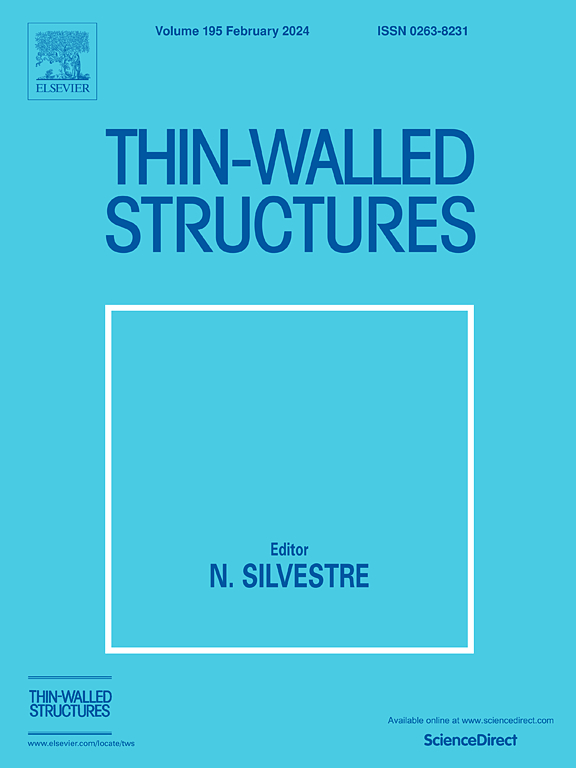预应力薄壁渡槽水压爆破损伤计算方法
IF 5.7
1区 工程技术
Q1 ENGINEERING, CIVIL
引用次数: 0
摘要
近年来,水工结构在爆炸荷载作用下的抗爆性能越来越受到人们的关注。预应力渡槽在爆破荷载作用下的破坏计算方法仍是一个复杂的问题。为此,介绍了水压爆破的计算理论,提出了水压爆破装药重量的计算公式。水下爆破模型的欧拉-拉格朗日(CEL)耦合算法的准确性通过之前的实验得到了验证。然后,建立了预应力渡槽的全耦合三维数值模型,以获取预应力渡槽在水压爆破作用下的动态性能和破坏机理。讨论了预应力和拉杆对水压爆破下预应力渡槽非线性动态性能和破坏模式的影响。最后,基于波动力学和材料力学,提出了水压爆破下预应力渡槽的计算方法。通过不同 TNT 重量下预应力渡槽遭受水压爆破的破坏模式,验证了所提方法的准确性。分析结果表明,所提出的方法能够满足预应力渡槽在水压爆破下的破坏特征与不同 TNT 重量之间的关系。1.5 千克 TNT 不足以完全击碎预应力渡槽,而 3.5 千克 TNT 则可造成完美的击碎效果。7.5 公斤 TNT 会导致预应力渡槽过度破碎,爆炸能量得不到有效利用。所提出的破坏计算方法可为预应力薄壁渡槽结构的爆炸分析提供重要支持。本文章由计算机程序翻译,如有差异,请以英文原文为准。
Damage calculation method for prestressed thin-walled aqueducts subjected to water pressure blasting
In recent years, the blast resistance of hydraulic structures under explosion loads has attracted more and more attention. The damage calculation method of prestressed aqueducts subjected to blasting load is still a complicated problem. For this purpose, the theory of computation of the water pressure blasting is introduced and the formula for calculating the charge weight of the water pressure blasting is presented. The accuracy of the Coupled Eulerian-Lagrangian (CEL) algorithm of the underwater explosion model is verified by the previous experiment. Then, a fully coupled three-dimensional numerical model of a prestressed aqueduct is established to acquire the dynamic performances and failure mechanisms of the prestressed aqueduct subjected to water pressure blasting. The influence of the prestress and pull rod on nonlinear dynamic performances and failure modes of a prestressed aqueduct subjected to water pressure blasting are discussed. Finally, based on the wave and material mechanics, a method of calculation for the prestressed aqueduct subjected to water pressure blasting is presented. The accuracy of the suggested method is validated by the damage mode of the prestressed aqueduct subjected to water pressure blasting under various TNT weights. The analysis results show that the proposed method can satisfy the relationship between the damage characteristics of the prestressed aqueduct to water pressure blasting and various TNT weights. 1.5 kg TNT is insufficient to completely shatter the prestressed aqueduct, while 3.5 kg TNT can cause a perfect crushing effect. 7.5 kg TNT will result in excessive fragmentation of the prestressed aqueduct and inefficient utilization of the explosive energy. The proposed damage calculation method can provide significant support for explosion analysis of the prestressed thin-walled aqueduct structure.
求助全文
通过发布文献求助,成功后即可免费获取论文全文。
去求助
来源期刊

Thin-Walled Structures
工程技术-工程:土木
CiteScore
9.60
自引率
20.30%
发文量
801
审稿时长
66 days
期刊介绍:
Thin-walled structures comprises an important and growing proportion of engineering construction with areas of application becoming increasingly diverse, ranging from aircraft, bridges, ships and oil rigs to storage vessels, industrial buildings and warehouses.
Many factors, including cost and weight economy, new materials and processes and the growth of powerful methods of analysis have contributed to this growth, and led to the need for a journal which concentrates specifically on structures in which problems arise due to the thinness of the walls. This field includes cold– formed sections, plate and shell structures, reinforced plastics structures and aluminium structures, and is of importance in many branches of engineering.
The primary criterion for consideration of papers in Thin–Walled Structures is that they must be concerned with thin–walled structures or the basic problems inherent in thin–walled structures. Provided this criterion is satisfied no restriction is placed on the type of construction, material or field of application. Papers on theory, experiment, design, etc., are published and it is expected that many papers will contain aspects of all three.
 求助内容:
求助内容: 应助结果提醒方式:
应助结果提醒方式:


